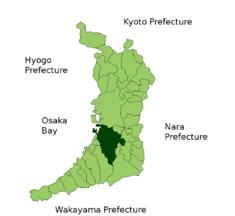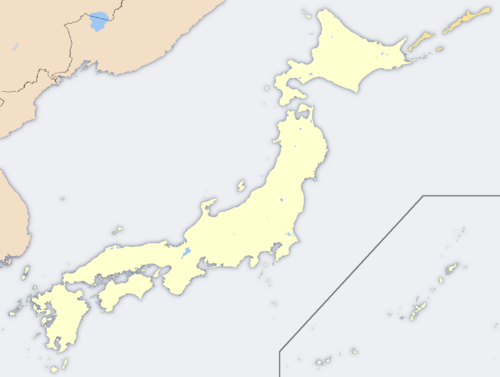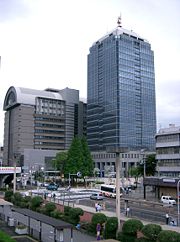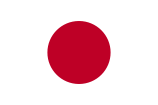Sakai, Osaka
 Sakai's location in Osaka, Japan. |
|
 Sakai's location in Japan. |
|
| Location | |
| Country | Japan |
| Region | Kansai |
| Prefecture | Osaka |
| Physical characteristics | |
| Area | 149.99 km2 (57.91 sq mi) |
| Population (as of July 1, 2008) | |
| Total | 835,516 |
| Density | 5,570 /km² (14,426 /sq mi) |
| Location | |
| Symbols | |
| Tree | Willow |
| Flower | Iris |
| Bird | Shrike |
 Flag |
|
| Sakai Government Office | |
| Mayor | Keisuke Kihara |
| Address | 3-1 Minamikawaramachi, Sakai-ku, Sakai-shi, Osaka-fu 590-0078 |
| Phone number | 072-233-1101 |
| Official website: City of Sakai | |
Sakai (堺市 Sakai-shi?) is a city in Osaka Prefecture, Japan. It has been one of the largest and most important seaports of Japan since the Medieval era.
Following the February 2005 annexation of Mihara Town in Minamikawachi District, the city has grown further and is now the fourteenth most populous city in Japan,[1] with 833,414 residents as of 2007-05-01.[2]

The current city was legally founded on April 1, 1889 according to the laws of Imperial Japan. Sakai became a designated city in April 2006[3] giving it a greater measure of self-determination in governmental affairs. It is divided into seven districts.
Sakai is known for its keyhole-shaped burial mounds, or kofun, which date from the 5th century. The largest of these, Daisen Kofun, is believed to be the grave of the Emperor Nintoku and is the largest grave in the world by area. Once known for samurai swords, Sakai is now famous for the quality of its kitchen knives; most high-quality Japanese cutlery originates in Sakai, and its production is a major industry in the city.
Contents |
History
In the Muromachi Period Sakai was one of richest cities in Japan. Sakai is located on the edge of Osaka Bay and at the mouth of the Yamato River, which connected the Yamato Province (now Nara Prefecture) to the sea. Sakai thus helped to connect foreign trade with inland trade.
Sakai was an autonomous city run by merchant citizens. In those days it was said that the richest cities were Umi Sakai, Riku Imai (tr. "along the sea, Sakai; inlands, Imai"). The famous Zen Buddhist priest Ikkyu chose to live in Sakai because of its free atmosphere. In the Sengoku Period some Christian priests, including St. Francis Xavier in 1550, visited Sakai and documented its prosperity.

After the coming of Europeans Sakai became a trade center of firearms, and a daimyo, Oda Nobunaga, was one of their important customers. During his ambitious attempt to unify Japan, Nobunaga attempted to take the autonomy privilege from Sakai. Sakai's citizens denied his order and pitched a desperate battle against his army. Most citizens fled; Sakai was burned and seized by Nobunaga. After the death of Nobunaga, one of his men, Toyotomi Hideyoshi, seized power. Sakai became a prosperous city again under his reign.
Sen no Rikyu, known as the greatest master of the tea ceremony, was originally a merchant of Sakai. Because of the close relationship between the tea ceremony and Zen Buddhism, and because of the prosperity of its citizens, Sakai was one of the main centers of the tea ceremony in Japan.
Sakai was still an important trade center during the Edo Period but was involved only in inland trade due to the Bakufu (Sakoku) policy of the Tokugawa government. At the end of this era Westerners again landed in Sakai, but it resulted in a tragic incident, because the Japanese citizenry and the foreigners were ignorant of each others' ways. French sailors from the Dupleix and Sakai citizens clashed; some French were killed, and subsequently the Japanese responsible for these deaths were sentenced to death by seppuku. This incident is called the Sakai Incident (堺事件 Sakai-jiken?).
In modern times, Sakai is an industrial city with a large port. As such, its western area suffered widespread damage from bombing raids during the Second World War. It is now known for its knives and is the home of Shimano bicycle parts. With a population of over 800,000, it is the largest suburb of Osaka City and the fourteenth-largest city in Japan.
Wards

Sakai has seven wards (ku):
- Sakai-ku (堺区?)
- Kita-ku (北区?)
- Nishi-ku (西区?)
- Naka-ku (中区?)
- Higashi-ku (東区?)
- Mihara-ku (美原区?)
- Minami-ku (南区?)
Sister cities and friendship cities
 Berkeley, California, United States - 1967
Berkeley, California, United States - 1967 Lianyungang, Jiangsu, People's Republic of China - 1983
Lianyungang, Jiangsu, People's Republic of China - 1983 Tanegashima, Kagoshima, Japan - 1986
Tanegashima, Kagoshima, Japan - 1986 Higashiyoshino, Nara, Japan - 1986
Higashiyoshino, Nara, Japan - 1986 Wellington, New Zealand - 1994
Wellington, New Zealand - 1994
Notables
- Emperor Nintoku
- Gyōki
- Ikkyu
- Sen no Rikyu
- Tsuda Sogyu
- Imai Sokyu
- Ōuchi Yoshihiro
- Takeno Jōō
- Ore Ska Band
- Nobuaki Kakuda
- Kentaro Kobuchi and Shunsuke Kuroda, the members of the music group Kobukuro
- Akiko Yosano, Japanese poet and novelist
- Hideo Nomo worked in Shin-nittetsu Sakai and played on its club team before he was scouted by the Kintetsu Buffaloes.
- Masayuki Ishikawa, author
- Yudetamago, mangaka duo (attended Hatsushiba High School in Higashi-ku)
References
- ↑ Sakai City profile. Accessed 2007-03-13. Note that although the reference refers to Sakai as the fourteenth-largest city in Japan, this reference excludes Tokyo.
- ↑ Sakai City Department of Planning, Head of Statistical Research (堺市企画部調査統計担当 Kikakubu Chōsa Tōkei Tantō?). Published 2007-05-21.
- ↑ "Tokyo pollsters in the money", Yomiuri Shimbun, 2007-02-17. Accessed 2007-03-13.
External links
- Sakai official website (Japanese)
|
|||
| Cities | |||
|---|---|---|---|
| Daitō | Fujiidera | Habikino | Hannan | Higashiōsaka | Hirakata | Ibaraki | Ikeda | Izumi | Izumiotsu | Izumisano | Kadoma | Kaizuka | Kashiwara | Katano | Kawachinagano | Kishiwada | Matsubara | Minoh | Moriguchi | Neyagawa | Osaka (capital) | Ōsakasayama | Sakai | Sennan | Settsu | Shijōnawate | Suita | Takaishi | Takatsuki | Tondabayashi | Toyonaka | Yao | |||
| Districts | |||
| Minamikawachi | Mishima | Senboku | Sennan | Toyono | |||
|
|
|||||||||||